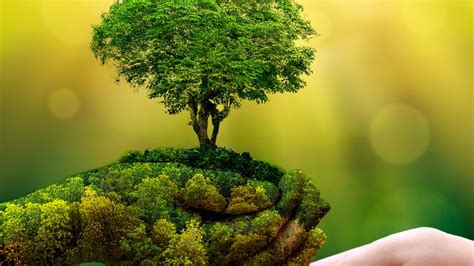Are you passionate about preserving and protecting the natural world around us? Do you want to learn more about the field of environmental conservation and the various strategies and initiatives being implemented to safeguard our planet’s biodiversity? In this blog post, we will delve into the fascinating and vital realm of environmental conservation. From understanding the fundamental principles of conservation to exploring the importance of preserving nature and the strategies being employed to achieve this, we will cover a wide range of topics. We will also examine the role of national parks and community-based initiatives in environmental preservation, as well as the advancements in technology that are contributing to conservation efforts. Join us as we uncover success stories and examples of effective conservation projects that are making a real difference in the world. Let’s delve into the world of environmental conservation and discover how we can all play a part in safeguarding nature’s wonders.
Table of Contents
Understanding Environmental Conservation
Environmental conservation refers to the practice of preserving, protecting, and managing natural resources and the environment. It involves taking actions to ensure the sustainability of ecosystems, habitats, and species for future generations. This includes efforts to prevent pollution, reduce carbon emissions, conserve biodiversity, and promote sustainable use of resources.
Understanding the importance of environmental conservation is crucial in addressing global environmental issues, such as climate change, habitat destruction, and loss of biodiversity. It requires a holistic approach that takes into account the interdependence of all living organisms and the environment. Conservation efforts aim to strike a balance between human development and the preservation of natural ecosystems.
Conservation is not just about protecting individual species or habitats; it is about maintaining the intricate web of life on Earth. This means considering the interconnectedness of various ecosystems and the impact of human activities on the environment. Conservation also involves educating and raising awareness about the importance of preserving nature and the consequences of overexploitation and pollution.
Environmental conservation is a complex and multifaceted endeavor that requires cooperation and collaboration across different sectors of society. It involves the participation of governments, non-profit organizations, businesses, and individuals working together to protect the environment. Understanding the various aspects of conservation is essential for developing effective strategies to address environmental challenges and ensure the long-term health of our planet.
The Importance of Preserving Nature
Preserving nature is essential for the well-being of our planet and all living organisms. It is crucial for maintaining the balance of ecosystems and the survival of various species. Additionally, nature provides numerous benefits to humans, such as clean air, water, and food. Preserving nature also contributes to the overall health and quality of life for people around the world.
Furthermore, the preservation of nature plays a significant role in combating climate change and its adverse effects. By protecting natural habitats and ecosystems, we can reduce carbon emissions and mitigate the impacts of global warming. This, in turn, helps to safeguard the planet for future generations.
Moreover, the aesthetic and recreational value of nature cannot be overlooked. It offers opportunities for outdoor activities, relaxation, and enjoyment, contributing to the mental and emotional well-being of individuals. Preserving nature ensures that these benefits are available for present and future generations to cherish and experience.
In conclusion, the importance of preserving nature cannot be overstated. It is crucial for ecological, environmental, and human health purposes. By recognizing and promoting the value of nature, we can work towards a sustainable and harmonious coexistence with the natural world.
Conservation Strategies for Biodiversity
Biodiversity, which refers to the variety of life on Earth, is a vital aspect of our planet’s health. It encompasses the diversity of ecosystems, species, and genes, and plays a crucial role in providing essential ecosystem services such as clean air and water, pollination, and climate regulation.
Conserving biodiversity is essential for maintaining the balance of natural ecosystems and ensuring the well-being of all living organisms. There are several strategies that can be implemented to protect and preserve biodiversity. One effective approach is the establishment of protected areas such as national parks, wildlife reserves, and marine sanctuaries. These areas provide a safe haven for a wide range of species and help to safeguard their natural habitats.
Another important conservation strategy is the promotion of sustainable land use and resource management practices. This involves minimizing habitat destruction, deforestation, and overexploitation of natural resources, and promoting responsible farming, forestry, and fishing practices. By adopting sustainable land use strategies, we can minimize the negative impacts on biodiversity and promote the coexistence of human activities with natural ecosystems.
Additionally, raising awareness and educating the public about the value of biodiversity and the importance of conservation is a key strategy in preserving the Earth’s natural heritage. Through education and outreach programs, individuals can learn about the threats to biodiversity, the benefits of conservation, and the actions they can take to contribute to the protection of biodiversity.
Restoration Ecology: Restoring Degraded Ecosystems
Restoration ecology is a vital field that focuses on restoring and revitalizing degraded ecosystems. These ecosystems may have been damaged due to human activities, natural disasters, or other factors, and restoration efforts aim to bring them back to their former health and functionality. This process typically involves a comprehensive assessment of the ecosystem’s current state, identification of key issues, and development of a restoration plan.
One of the key aspects of restoration ecology is the application of ecological principles to guide the reestablishment of natural processes and functions within the degraded ecosystem. This often involves reintroducing native plant and animal species, removing invasive species, and addressing factors such as soil erosion and nutrient balance. The goal is to create a self-sustaining and resilient ecosystem that can thrive without ongoing human intervention.
Restoration ecology also plays a crucial role in addressing pressing environmental challenges such as habitat loss, climate change, and declining biodiversity. By restoring degraded ecosystems, we can enhance the overall health of the environment, protect endangered species, and contribute to the resilience and adaptability of natural landscapes in the face of changing environmental conditions.
Overall, restoration ecology serves as a powerful approach to conservation and environmental stewardship by actively addressing the impacts of human activities and natural disturbances on ecosystems. Through thoughtful and scientifically informed restoration efforts, we can work towards sustaining a healthier and more balanced natural world for future generations.
Sustainable Development and Conservation
Sustainable development and conservation go hand in hand when it comes to preserving our planet for future generations. Conservation efforts are essential to ensure the longevity of our natural resources, while sustainable development aims to meet the needs of the present without compromising the ability of future generations to meet their own needs. By finding a balance between these two ideals, we can work towards a healthier and more secure future for the planet.
One of the key principles of sustainable development and conservation is the idea of protecting ecosystems and biodiversity. By preserving natural habitats and ensuring the survival of diverse species, we can maintain the delicate balance of our environment. This is crucial for the wellbeing of both wildlife and humans, as we all rely on the resources provided by our ecosystems.
Another important aspect of sustainable development and conservation is the promotion of renewable energy and responsible resource management. By investing in clean and sustainable energy sources, we can reduce our reliance on fossil fuels and decrease our impact on the environment. Additionally, responsible resource management ensures that we are not depleting our natural resources at a rate faster than they can be replenished.
Ultimately, sustainable development and conservation require a shift in mindset and a commitment to making choices that prioritize the long-term health of our planet. By incorporating these principles into our everyday lives, we can work towards a more sustainable future for all beings that call Earth home.
Balancing Human Needs with Conservation Efforts
Conservation efforts are essential for preserving our planet’s natural resources and maintaining a healthy environment for future generations. However, it is also crucial to consider the needs of human populations when implementing conservation strategies. Balancing these two priorities is a complex task that requires thoughtful consideration and careful planning.
One way to achieve this balance is through the implementation of sustainable development practices. By incorporating environmental considerations into urban planning, agriculture, and infrastructure development, we can ensure that human activities do not have a detrimental impact on the natural world. This can involve the use of renewable energy sources, sustainable agriculture techniques, and the protection of natural habitats.
Another important aspect of balancing human needs with conservation efforts is the involvement of local communities. By engaging with and empowering the people who live in and rely on natural areas, conservation projects can be more successful and sustainable in the long term. Community-based conservation initiatives can ensure that local populations benefit from the preservation of natural resources and are invested in the success of conservation efforts.
Ultimately, finding a balance between human needs and conservation efforts requires collaboration and cooperation between governments, non-profit organizations, businesses, and local communities. By working together, we can create solutions that benefit both people and the planet, ensuring a sustainable and harmonious coexistence.
The Role of National Parks in Environmental Preservation
National parks play a crucial role in environmental preservation by protecting and conserving natural resources and biodiversity. These parks serve as havens for a wide variety of plant and animal species, providing them with a safe and undisturbed habitat to thrive in. By designating certain areas as national parks, governments are able to safeguard important ecosystems and prevent them from being destroyed or disrupted by human activities.
In addition to preserving nature, national parks also offer opportunities for education and recreation to the public. Visitors to these parks can learn about the importance of conservation and gain a greater appreciation for the natural world. This, in turn, can lead to increased support for environmental protection efforts and a greater understanding of the need to preserve ecosystems for future generations.
Furthermore, national parks contribute to sustainable development by fostering ecotourism and providing economic benefits to local communities. By attracting tourists and nature enthusiasts, these parks can generate revenue that can be used for ongoing conservation efforts and the maintenance of the park infrastructure. This creates a positive cycle where the protection of natural resources leads to economic opportunities that support further preservation initiatives.
Overall, national parks are instrumental in environmental preservation and play a vital role in safeguarding ecosystems and biodiversity. By protecting natural habitats, raising awareness about conservation issues, and promoting sustainable ecotourism, these parks contribute to the long-term well-being of our planet and help ensure that future generations can continue to enjoy the beauty of nature.
Community-Based Conservation Initiatives
Community-based conservation initiatives play a crucial role in preserving and protecting the environment. These initiatives involve local communities in the efforts to conserve natural resources, biodiversity, and ecosystems. By engaging with the community, these projects ensure sustainable conservation practices that are in line with the needs and priorities of the local people.
One of the key benefits of community-based conservation is the sense of ownership and responsibility it instills in the local population. When communities are actively involved in conservation efforts, they are more likely to take pride in their natural environment and work towards its protection. This sense of ownership also leads to long-term sustainability, as the community members become stewards of their own natural resources.
Furthermore, community-based conservation initiatives often incorporate traditional ecological knowledge and practices of indigenous communities. This not only strengthens the conservation efforts but also provides valuable insights into sustainable resource management. By acknowledging and integrating traditional knowledge, these initiatives respect the cultural heritage of the local communities while contributing to the overall success of the conservation projects.
Additionally, community-based conservation fosters social and economic development within the local population. By creating opportunities for eco-tourism, sustainable agriculture, and other environmentally friendly activities, these initiatives promote the well-being of the community members while simultaneously protecting the natural environment.
Advancements in Technology for Conservation
Advancements in technology have played a crucial role in revolutionizing the field of conservation. With the rise of innovative tools and techniques, researchers and conservationists are now able to gather data more efficiently, monitor ecosystems more effectively, and implement conservation strategies with greater precision.
One significant advancement is the use of drones for conservation purposes. Drones equipped with high-resolution cameras and sensors can provide aerial imagery and data collection, which is especially useful in monitoring wildlife populations, tracking habitat changes, and conducting surveys in remote or inaccessible areas.
Furthermore, satellite technology has greatly contributed to conservation efforts by enabling researchers to monitor deforestation, track changes in land use, and identify areas of high biodiversity from space. This has allowed for the implementation of targeted conservation measures and the protection of critical habitats on a global scale.
In addition, the development of genomic technologies has revolutionized conservation biology by providing insights into genetic diversity, population dynamics, and species interactions. These advancements have been instrumental in informing conservation strategies, identifying at-risk populations, and enhancing the success of captive breeding and reintroduction programs.
Success Stories: Examples of Effective Conservation Projects
Conservation efforts around the world have brought about numerous success stories that serve as shining examples of effective environmental preservation. These projects have demonstrated the power of community involvement, technological advancements, and innovative strategies in achieving significant positive impacts on the environment.
One such success story is the reintroduction of the California condor, a critically endangered species, back into the wild. Through collaborative efforts between wildlife conservation organizations, government agencies, and local communities, the California condor population has experienced a remarkable recovery. This success story showcases the effectiveness of multi-stakeholder partnerships in species conservation.
In another inspiring example, the restoration of degraded coral reefs in the Caribbean has demonstrated the potential for ecologically sustainable practices to revitalize fragile marine ecosystems. By implementing artificial reef structures, engaging in coral transplantation, and regulating tourism activities, marine conservationists have successfully restored the health and biodiversity of damaged coral reefs, providing hope for the future of these vital marine habitats.
Furthermore, the conservation of the giant panda in China stands as a testament to the impact of dedicated conservation initiatives. Through the establishment of protected reserves, captive breeding programs, and habitat restoration efforts, the giant panda population has rebounded from the brink of extinction, symbolizing the triumph of conservation measures in safeguarding iconic species.






